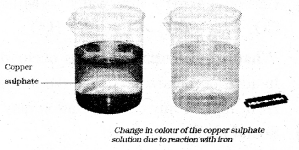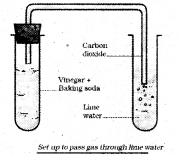Students can Download Chapter 6 Physical and Chemical Changes Questions and Answers, Notes Pdf, KSEEB Solutions for Class 7 Science, Karnataka State Board Solutions help you to revise complete Syllabus and score more marks in your examinations.
Karnataka State Syllabus Class 7 Science Chapter 6 Physical and Chemical Changes
Class 7 Science Physical and Chemical Changes NCERT Textbook Questions and Answers
KSEEB Solutions For Class 7 Science Chapter 6 Question 1.
Classify the changes involved in the following processes as physical or chemical changes:
Answer:
| (a) Photosynthesis | Chemical change |
| (b) Dissolving sugar in water | Physical change |
| (c) Burning of coal | Chemical change |
| (d) Melting of wax | Physical change |
| (e) Beating aluminium to make aluminium toil | Physical change |
| (f) Digestion of food | Chemical change. |
KSEEB Solutions For Class 7 Science Question 2.
State whether the following statements are true or false. In case a statement is false, write the corrected statement in your notebook.
(a) Cutting a log of wood into pieces is a chemical change. (True/False)
Answer:
False
(b) Formation of manure from leaves is a physical change. (True/False)
Answer:
False
(c) Iron pipes coated with zinc do not get rusted easily. (True/False)
Answer:
True
(d) Iron and rust are the same substances. (True/False)
Answer:
False
(e) Condensation of steam is not a chemical change. (True/False)
Answer:
True
KSEEB Solutions For Class 7 Science Physical And Chemical Changes Question 3.
Fill in the blanks in the following statements:
(a) When carbon dioxide is passed through ‘ lime water, it turns milky due to the formation of Calcium carbonate (CaCo3)
(b) The chemical name of baking soda is Sodium hydrogen carbonate
(c) Two methods by which rusting of iron can be prevented are Galvanization and painting
(d) Changes in which only Physical properties of a substance change are called physical changes.
(e) Changes in which new substances are formed are called chemical changes.
KSEEB Solutions For Class 7 Question 4.
When baking soda is mixed with lemon juice, hubbies are formed with the evolution of a gas. What type of change is it? Explain.
Answer:
When baking soda (Sodium hydrogen carbonate) is mixed with lemon juice (citric acid), bubbles are formed. The bubbles are formed due to the evolution of carbon dioxide gas. This is a chemical change involving the formation of new substances.
Lemon juice + Baking soda ➝ Carbon dioxide + Other substances.
KSEEB Solutions 7th Standard Science Question 5.
When a candle burns, both physical and chemical changes take place. Identify these changes. Give another example of a familiar process in which both the chemical and physical changes take place.
Answer:
When candle bums, both physical and chemical changes take place. During the burning of a candle, the wax of the candle melts. This is a physical change because no new substance is formed. The molten wax solidifies on cooling.
During burning of a candle, the wax and the wick of the candle bum and form new substances, i.e. carbon dioxide and water vapour. This is a chemical change.
Usage of LPG in kitchen is a similar example. It is a physical change because LPG changes from liquid to gas when gets released from the cylinder into the tube. It is a chemical change because LPG produces new substances on burning.
KSEEB Solutions Class 7 Science Question 6.
How would you show that setting of curd is a chemical change?
Answer:
Setting of curd is chemical change since a new substance (lactic acid) is formed which differs in taste from the original substance (fats and proteins) i.e., milk. Also the change is irreversible (curd cannot be converted into milk).
KSEEB Solutions For 7th Class Science Question 7.
Explain why burning of wood and cutting it into small pieces are considered as two different types of changes.
Answer:
Burning of wood is a chemical change because wood on burning converted to new substances like ash (carbon), carbon dioxide gas watervapour, heat and light. The change is irreversible. While cutting of wood smaller pieces is a physical change because the original composition of wood does not change. No new substances are formed.
KSEEB 7th Science Solutions Question 8.
Describe how crystals of copper sulphate are prepared. crystals of copper sulphate are prepared by the method of crystallization. The process is as follows.
Answer:
- Take a cupful of water in a beaker.
- Add few drops of dilute sulphuric acid to this.
- The water is then heated and when it starts bailing, copper sulphate powder is added with stirring.
- Copper sulphate powder should be added on till the solution becomes saturated. It is then filtered into a China dish and allowed to cool.
- The solution should kept undisturbed shows, the crystals of copper sulphate seperate out.
KSEEB Solutions For 7 Science Question 9.
Explain how painting of an iron gate prevents it from rusting.
Answer:
For rusting, the presence of both is required. The coat of the paint prevents direct contact of iron with air and oxygen and this prevents it from rusting.
KSEEB Solutions Science Class 7 Question 10.
Explain why rusting of iron objects is faster in coastal areas than in deserts.
Answer:
Both air and moisture are required for rusting to take place. In coastal areas, the quantity of moisture present in air is more than that in deserts. In desert areas, the amount of moisture in air is even lower. Therefore, rusting of iron objects is faster in coastal areas than in deserts.
Class 7 Science Chapter 6 Notes Question 11.
The gas we use in the kitchen is called liquified petroleum gas (LPG). In the cylinder it exist as a liquid. When it comes out from the cylinder it becomes a gas (Change – A) then it burns (Change – B). The following statements pertain to these changes. Choose the correct one.
(i) Process – A is a chemical change.
(ii) Process – B is a chemical change.
(iii) Both processes A and B are chemical changes.
(iv) None of these processes is a chemical change.
Answer:
ii. Process – B is a chemical change.
KSEEB Solutions 7th Science Question 12.
Anaerobic bacteria digest animal waste and produce biogas (Change – A) The biogas is then burnt as fuel (Change -B). The following statements pertain to these changes. Choose the correct one.
Answer:
(i) Process – A is a chemical change.
(ii) Process – B is a chemical change.
(iii) Both processes A and B are chemical changes.
(iv) None of these processes is a chemical change.
Answer:
iii. Both processes A and B are chemical changes.
Class 7 Science Physical and Chemical Changes Additional Important Questions and Answers
Science KSEEB Solutions For Class 7 Question 1.
How many types of changes come across in our surroundings? Name them.
Answer:
There are two types of changes. They are
- Physical Change
- Chemical Change
KSEEB Solution For Class 7 Science Question 2.
Define Physical change, give example.
Answer:
A change in which a substance undergoes a change in its physical properties such as shape, size, colour and State is called a physical change. A Physical Change is generally reversible, (some exceptions). In this change no new substance is formed.
KSEEB Solutions For Class 7 Social Science Chapter 6 Question 3.
What is rusting?
Answer:
Whenever iron things kept in open places for some time, it acquires a thin film of brownish substance. This is rust and this process is rusting. Chemically iron comes in contact with oxygen and water the reaction takes place forming iron oxide. This can be represented by an equation
Fe + O2 + H2O ➝ Fe2O3
7th Standard Science Notes Question 4.
Give one example of chemical change.
Answer:
Get a small piece of cleaned magnesium ribbon. Bring the tip near a candle flame. It bums with brilliant white light and leaves powdery ash. This is a chemical change. It is represented by an equation.
Magnesium + Oxygen Magnesium Oxide
Mg + O2 ➝ MgO.
KSEEB Class 7 Science Solutions Question 5.
How do you prepare magnesium hydroxide?
Answer:
We can dissolve the ash comes in the above reaction with water gives Magnesium hydroxide
Magnesium Oxide + water ➝ Magnesium hydroxide
MgO + H2O ➝ Mg(OH)2</sub
KSEEB Solution For Class 7th Science Question 6.
Write a neat diagram and explain how the change in colour of the copper sulphate solution due to reaction with iron.
Answer:

Dissolve about a teaspoonful of copper sulphate (blue vitrial or neela thotha) in about half a cup of water in a glass beaker. Add a few drops of dilute sulphuric acid to the solution, save a small sample of this blue solution in a test tube separately. Drop an iron nail into glass beaker. Wait for half an hour. Observe. The blur colour becomes green, compare with it to the sample in the test tube. This is chemical reac-tion. It is represented by an equation.
Copper Sulphate + Iron ➝ Iron sulphate (green) + Copper (brown deposit on the iron)
In the above reaction copper sulphate changes into iron sulphate and separated copper deposits on iron nail.
7th Standard Science 6th Lesson Question 7.
Draw a neat diagram and explain the Chemical change when carbon dioxide gas is passed through lime water.
Answer:

When carbon dioxide is passed through lime water, Calcium Carbonate, is formed Which makes lime water milky.
Take one spoon of vinegar in the test tube and add a pinch of baking soda, the reaction takes place, carbon dioxide gas evolves making bubbles, This gas is passed through freshly prepared lime water. It turns milky. (The turning of lime water into milky is a standard test of Carbon dioxide.) The above chemical reaction is represented as :
- Vinegar + baking soda ➝ Carbon dioxide + other things Acetic acid + Sodium Hydrogen Carbonate } ➝CO2 +etc.,
- Carbon dioxide + lime water Milky solution CO2 + Ca(OH)2 ➝ CaCO3 + H2O.
7th Standard Science Notes Karnataka State Syllabus Question 8.
What, are the other changes occur during Chemical reaction?
Answer:
In addition to new products, the following may accompany a chemical change :
- Heat, light or any other radiation may be given off or absorbed.
- Sound may be produced.
- A change in smell may take place or a new smell may be given off.
- A colour change may take place.
- A gas may be formed.
Some examples for above statements
- Burning of any substance is always accompanied by the production of heat and light.
- Explosion of fireworks produce heat, light and sound. During this the unpleasant gases will produce and pollute the atmosphere. (It is not advisable, so it is avoided).
- The stale food gives bad adour (smell)
- The cut fruits and vegetables change its colour after some time.
7th Standard Science Textbook Karnataka State Syllabus Question 9.
How to prevent rusting ?
Answer:
Rusting can be prevented by painting or applying grease periodically or galvanization.
KSEEB Solutions For Science Class 7 Question 10.
What is meant by galvanization?
Answer:
The process of depositing a layer of zinc on iron is called galvanization.
Question 11.
Define Crystallisation.
Answer:
The process of obtaining large crystals of pure substances from their solutions is called Crystallisation.